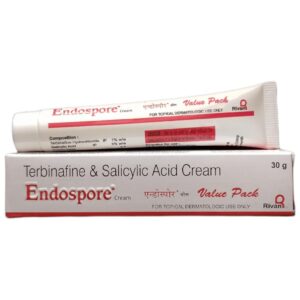SALICYCLIC ACID + TERBINAFINE
Salicyclic Acid: Drug: Salicylic Acid
Use: Salicylic acid is primarily used as a topical medication for the treatment of various skin conditions. It is commonly used to treat acne, psoriasis, and warts. It exfoliates the skin and helps to remove the outer layer of dead skin cells, unclogs pores, and reduces inflammation.
Mechanism of Action: Salicyclic acid works by softening and loosening the skin cells in the outer layer of the skin. It also has anti-inflammatory properties that help to reduce swelling and redness associated with skin conditions. Additionally, it can inhibit the production of certain substances in the body that lead to inflammation.
Dose: Salicylic acid is typically available as a cream, gel, lotion, or ointment. The concentration of salicylic acid can vary depending on the product and the specific condition being treated. It is important to follow the instructions provided by your healthcare professional or the product label. Generally, it is applied to the affected area once or twice daily. However, the exact dose and duration of treatment may vary depending on the severity of the condition.
Side Effects: Common side effects of salicylic acid include skin irritation, redness, dryness, and peeling at the application site. These side effects are usually mild and transient. However, if any severe or persistent side effects occur, it is important to consult a healthcare professional. It is important to avoid applying salicylic acid to broken or irritated skin as it may cause further irritation. Additionally, excessive use of salicylic acid may lead to systemic effects such as dizziness, headache, nausea, and tinnitus. In rare cases, allergic reactions may occur, characterized by itching, rash, swelling, or difficulty breathing. If any allergic reactions are experienced, immediate medical attention should be sought.
Disclaimer: The information provided here is for informational purposes only and should not be used as a substitute for professional medical advice. Always consult a healthcare professional before starting or changing any medication.
Terbinafine: Terbinafine, sold under the brand name Lamisil, is an antifungal medication used to treat various fungal infections. It is commonly used to treat infections of the skin, including ringworm, athlete’s foot, and jock itch. It can also be used to treat fungal infections of the nails.
Terbinafine works by inhibiting the enzyme squalene epoxidase, which is essential for the synthesis of ergosterol, a key component of fungal cell membranes. By disrupting fungal cell membrane synthesis, terbinafine effectively prevents the growth and replication of the fungus.
The typical dose of terbinafine for treating fungal infections is 250mg once daily for 6 weeks for skin infections, and 250mg once daily for 12 weeks for nail infections. The duration of treatment may vary depending on the severity of the infection and the location.
Like any medication, terbinafine may cause side effects. The most common side effects include gastrointestinal symptoms such as upset stomach, diarrhea, and nausea. It may also cause changes in taste or loss of taste. In rare cases, it can lead to liver damage, so regular liver function tests are recommended during treatment. Other rare side effects include rash, headache, dizziness, and muscle or joint pain.
It is important to inform your healthcare provider about any existing medical conditions or medications you are taking, as terbinafine can interact with certain drugs, such as certain antidepressants and antifungal medications. It is not recommended for pregnant or breastfeeding women, as its safety in these populations has not been fully established.

